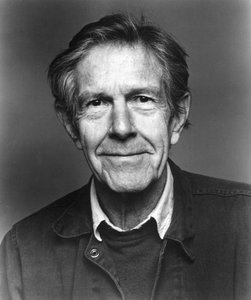One of the most unusual musical events of the season occurs at Corthell Hall on the Gorham campus of the University of Southern Maine this Friday. Noted “modern” music interpreter Bridget Convey, who now lives in Hallowell, will play John Cage’s complete Sonatas and Interludes for prepared piano.
The word “modern” is in quotes because Cage (1912-’92) invented the prepared piano, and composed this avant garde music between 1946 and 1948. The recital is in honor of his 101st birthday.
Convey will be preparing the piano in Corthell Hall Friday morning, and will lead a workshop of the USM Composers Ensemble at 2 p.m. The performance is at 8 p.m.
Cage’s original objects for altering the sound of a piano were bolts, screws and pieces of weather-stripping. He first tried nails, which would not stay put between the strings, and aluminum pie pans, which made an interesting sound but tended to walk off because of the vibration.
Cage was either a jack of all trades or a Renaissance man, depending upon one’s valuation of his works — but I tend toward the latter. He was an artist, writer, performer (piano and percussion), philosopher, educator and composer, tutored gratis by Schoenberg for his devotion to the art.
He also moved in exalted circles. He was a close friend of painter Max Ernst and a collaborator with his wife, surrealist painter Dorothea Tanning. He lived rent-free at Peggy Guggenheim’s place in New York until they had a falling out over an exhibit at the Museum of Modern Art.
As a composer, he was one of the most influential of the 20th century, leading on the one hand to the minimalist works of Philip Glass and Steve Reich, and on the other to various New Age confections. To the general public, he is best known for the piano work 4’33” — the designated interval of what most assume to be silence but is actually a period of intensified listening to ambient sounds.
The famous piano piece — the easiest in the world to play — is an extension of Cage’s philosophy of composition, the basis of which is the alternation of sound and silence.
Sonatas and Interludes is a work of fusion, combining the sonata form of Scarlatti with contemporary sounds and sensibility, rather like Prokofiev’s “Classical Symphony” on steroids.
It is also strongly influenced by Indian music and philosophy. The purpose of music, according to one school of thought, is “to sober and quiet the mind, thus rendering it susceptible to divine influences.” Cage accepted this dictum in both art and music after the 1940s. He also agreed with Indian art historian Ananda K. Coomaraswamy’s notion of the eight “permanent emotions” — humor, wonder, erotic and heroic (white), and anger, fear, disgust and sorrow (black).
Divine influences molded Cage’s later works, based on the chance combinations of the Chinese “I Ching” or “The Book of Changes.”
Philosophy aside, the Sonatas and Interludes are a delight to hear, full of driving rhythms and even melody. The percussive-sounding ones are Eastern and the bell-like are Western, according to Cage. But they are all fun to hear and good, perhaps great, music of our time.
The performance will also feature a premiere presentation by video artist Hillary Tozier.
Tickets are $15 ($10 for seniors and USM employees and alumni) and $5 for students. Reservations may be made online at usm.maine.edu/music/boxoffice or by calling the USM Music Box Office at 780-5555.
Christopher Hyde is a writer and musician who lives in Pownal. He can reached at:
classbeat@netscape.net
Copy the Story Link
Send questions/comments to the editors.



Success. Please wait for the page to reload. If the page does not reload within 5 seconds, please refresh the page.
Enter your email and password to access comments.
Hi, to comment on stories you must . This profile is in addition to your subscription and website login.
Already have a commenting profile? .
Invalid username/password.
Please check your email to confirm and complete your registration.
Only subscribers are eligible to post comments. Please subscribe or login first for digital access. Here’s why.
Use the form below to reset your password. When you've submitted your account email, we will send an email with a reset code.